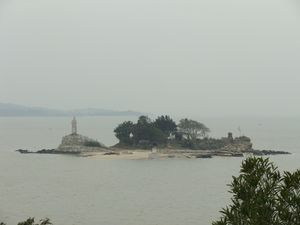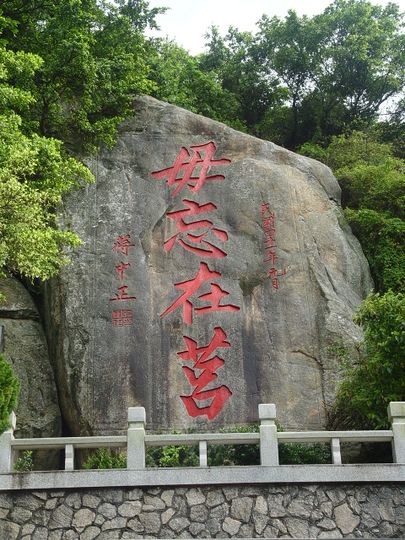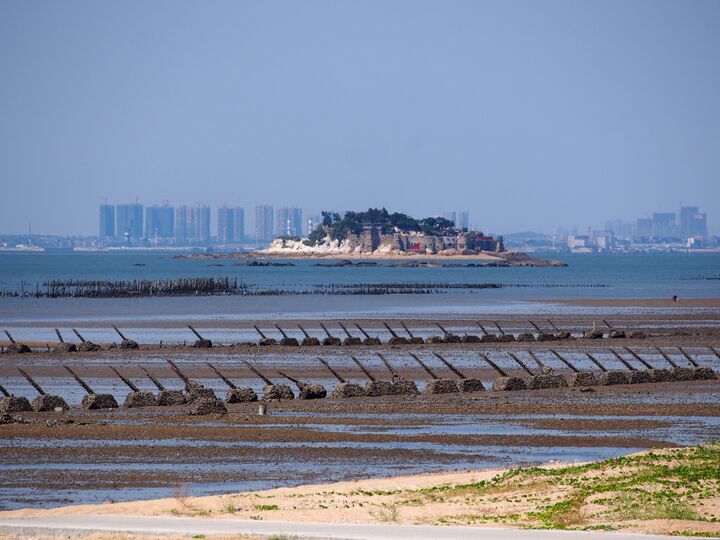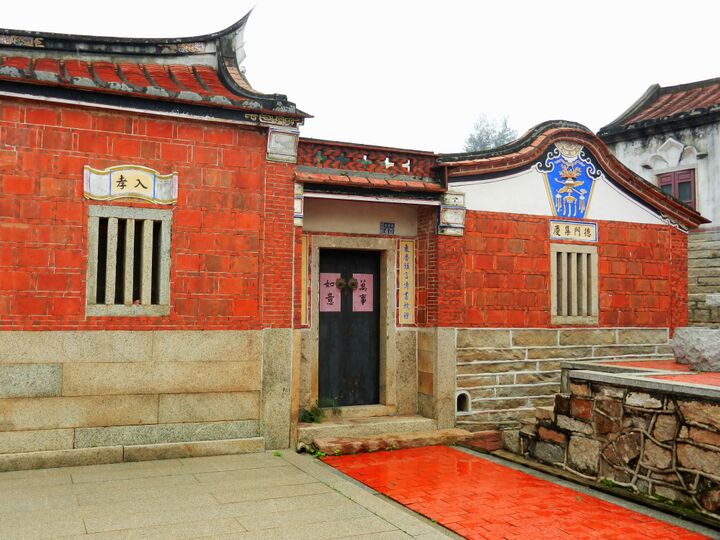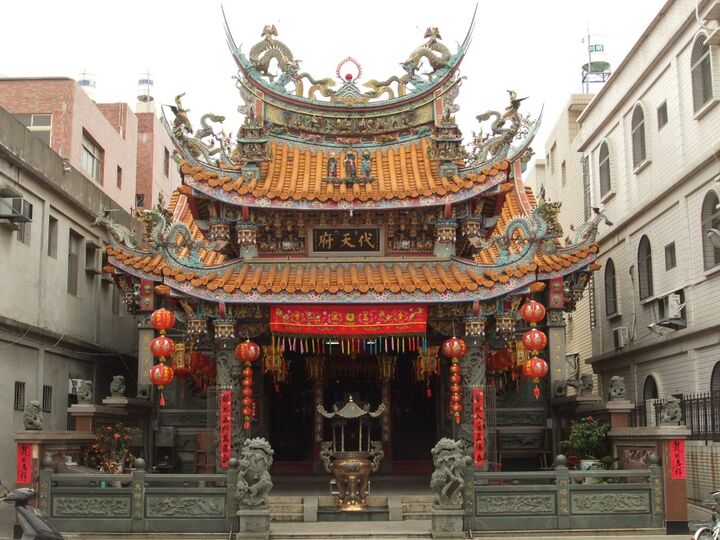كينمن
Kinmen County
金門縣 | |
|---|---|
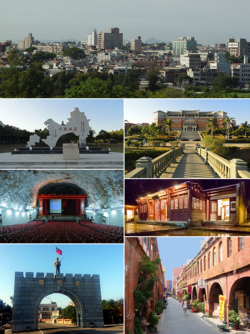 | |
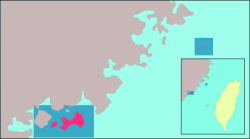 | |
| الإحداثيات: 24°26′N 118°20′E / 24.44°N 118.33°E | |
| البلد | جمهورية الصين[Note 1] |
| المقر | Jincheng |
| أكبر مدينة | Jincheng |
| الأحياء | 0 مدينة، 6 بلدات (3 حضرية، 3 ريفية) |
| الحكومة | |
| • مدير الناحية | Chen Fu-hai (مستقل) |
| • نائب مدير الناحية | Lin De-gong (林德恭) |
| المساحة | |
| • الإجمالي | 153٫1 كم² (59٫1 ميل²) |
| ترتيب المساحة | 20 of 22 |
| التعداد (ديسمبر 2014) | |
| • الإجمالي | 127٬723 |
| • الترتيب | 20 من 22 |
| • الكثافة | 830/km2 (2٬200/sq mi) |
| منطقة التوقيت | UTC+8 (التوقيت القياسي الوطني) |
| الموقع الإلكتروني | www.kinmen.gov.tw |
| الرموز | |
| الطائر | هدهد |
| الزهرة | أوركيد الفصول الأربع |
| الشجرة | شجرة القطن |
| Kinmen | |||||||||||||||||||||||||||||||||
|---|---|---|---|---|---|---|---|---|---|---|---|---|---|---|---|---|---|---|---|---|---|---|---|---|---|---|---|---|---|---|---|---|---|
| الصينية التقليدية | 金門 | ||||||||||||||||||||||||||||||||
| الحروف المبسطة | 金门 | ||||||||||||||||||||||||||||||||
| هانيو پنين | Jīnmén | ||||||||||||||||||||||||||||||||
| البريد | Quemoy | ||||||||||||||||||||||||||||||||
| |||||||||||||||||||||||||||||||||
| Kinmen County | |||||||||||||||||||||||||||||||||
| الصينية التقليدية | 金門縣 | ||||||||||||||||||||||||||||||||
| الحروف المبسطة | 金门县 | ||||||||||||||||||||||||||||||||
| هانيو پنين | Jīnmén Xiàn | ||||||||||||||||||||||||||||||||
| |||||||||||||||||||||||||||||||||
كينمن Kinmen أو كيموي (Quemoy ؛ /kɪˈmɔɪ/؛ انظر أيضاً قِسم "الأسماء" أدناه)، رسمياً ناحية كينمن (الصينية: 金門縣; پنين: Jīnmén Xiàn; Pe̍h-ōe-jī: Kim-mûi Kōan)، هي مجموعة من الجزر، تحكمها جمهورية الصين (ROC)، والتي تقع مباشرةً مقابل الساحل الجنوبي الشرقي لـبر الصين الرئيسي.[1] وتضم المجموعة كينمن الكبرى، كينمن الصغرى، ووچيو والعديد من الجـُزَيرات المحيطة. وهي واحدة من ناحيتين ضمن مقاطعة فوجيان المنسقة في جمهورية الصين. وتقع على بعد 2 كيلومتر شرق مدينة البر الرئيسي شيامن، لذا فموقعها الاستراتيجي يعكس التغير الهام في العلاقات عبر المضيق من المواجهة العسكرية إلى تحولها لنقطة تجارة بين الصين وتايوان. كينمن هي واحدة من ناحيتين تكونان مقاطعة فوجيان، الأخرى هي ناحية ليإنتشيانگ (ماتسو). وبسبب القضية المستمرة حول الوضع السياسي لتايوان، فإن جمهورية الصين الشعبية (PRC) طالبت بإستمرار بـ كينمن كجزء من چوانژو المدينة بمستوى محافظة في مقاطعة فوجيان بجمهورية الصين الشعبية.
الموقع الاستراتيجي لكينمن في مضيق تايوان أدى إلى العديد من المواجهات، مما يجعلها نجسيداً محسوساً للتغير السياسي في العلاقات عبر المضيق. ففي أغسطس 1958، تعرضت كينمن لقصف شديد من جيش التحرير الشعبي أثناء أزمة مضيق تايوان الثانية. تم رفع قيود السفر بين كينمن وجزيرة تايوان الرئيسية في عام 1994 بعد نهاية عقود طويلة من الإدارة العسكرية على كينمن. تم افتتاح عبّارة مباشرة إلى شيامن في يناير 2001 بعد إنشاء الروابط الثلاثة.[2]
تزعم جمهورية الصين الشعبية (PRC، الصين) أن كينمن جزء من مقاطعة فوجيان وتعتبر ووچيو إقليماً منفصلا لفوجيان منفصلاً عن كينمن نفسها؛ وعلى العكس من ذلك، تزعم جمهورية الصين أن جزر دادنگ (تاتنگ) كجزء من كينمن، على الرغم من أنهم قد نـُقِلوا فعلياً إلى سيطرة جمهورية الصين الشعبية على شيامن.
الأسماء
كينمن was given its name (金門; Jīnmén; 'golden gate') in 1387 when the Hongwu Emperor of China's Ming dynasty appointed a military officer to administer the island and protect it from wokou (pirate) attacks.[3] The name is pronounced Jīnmén in the official Standard Chinese but some of the various names used in English for the islands derive from other Chinese varieties.
كيموي Quemoy هو اسم الجزيرة بالإنگليزية وبعدد من اللغات الأوروپية وهو كذلك اسم الجزيرة في الرومنة البريدية.[4] It likely began as a Portuguese transcription of the Zhangzhou Hokkien pronunciation of the name, Kim-mûi.[5] This form of the islands' name was used almost exclusively in English until the late 20th century and is still used widely in current English-language contexts that involve historical coverage. For example, current works that deal with the أزمتي مضيق تايوان الأولى والثانية (the Quemoy Incident[6]) when the islands received prominent worldwide news coverage as "Quemoy" still use this form. In addition, the former National Kinmen Institute of Technology was renamed National Quemoy University in 2010. Kinmen scholar Wei Jian-feng advocates the use of "Quemoy" to better connect the island to "international society or achieve more recognition in the world".[5]
Kinmen is a more recent transcription based on the general rules of the postal romanization system. With some exceptions, this form is used in most current English-language contexts on Kinmen and in Taiwan as a whole. Entities such as the county government,[7] the islands' airport,[8] and the national park[9] use this spelling.
Chin-men is the Wade–Giles romanization form of the island's name and appears on some maps using that as their standard.[10]
Jinmen is the Hanyu Pinyin form of the island's name used especially in sources from the People's Republic of China.[11] The Kinmen County Government and ROC central government have adopted Hanyu Pinyin as their standard romanization, such as for names of townships within Kinmen County, but this does not apply to the name of Kinmen itself.[12]
التاريخ

أسرة تانگ
People began settling down في كينمن في عهد أسرة تانگ, changing the original name from Wuzhou to كينمن.[13]
أسرة مينگ
في عهد أسرة مينگ، more migrants came to settle down in Kinmen. كوشينگا used Kinmen as a base to liberate Kinmen and Penghu from the Dutch. He cut down trees to build his navy, resulting in massive deforestation that made Kinmen vulnerable to soil erosion.[13]
أسرة تشينگ
Prince of Lu, a member of the أسرة مينگ الجنوبية, resisted the invading Manchu قوات أسرة تشينگ. In 1651, he fled to Kinmen, which the Qing dynasty took in 1663.[14] Although Taiwan and Penghu had been ceded to Japan in 1895 via the Treaty of Shimonoseki, Kinmen was not included in the cession.[مطلوب توضيح]
جمهورية الصين
بعد تأسيس جمهورية الصين (ROC) في 1912, Kinmen became part of Fukien Province. Japan did however occupy Kinmen during the Second Sino-Japanese War from 1937 to 1945. After the establishment of the People's Republic of China (PRC) in October 1949, it was later claimed by both the ROC and PRC.
The People's Liberation Army extensively shelled the island during the First and Second Taiwan Strait crises in 1954-1955 and 1958 respectively. In 1954, the United States considered responding by using nuclear weapons against the PRC.[15]
Kinmen was originally a military reserve, which eventually led to the tragedy of 1987 Lieyu massacre.[16] The island was returned to the civilian government in the mid-1990s, after which travel to and from it was allowed. Direct travel between mainland China and Kinmen re-opened in January 2001 under the mini Three Links, and there has been extensive tourism development on the island in anticipation of mainland tourists.[17] Direct travel was suspended in 2003 as a result of the SARS outbreak, but has since resumed.
Many Taiwanese businesspeople use the link through Kinmen to enter the Chinese mainland, seeing it as cheaper and easier than entering through Hong Kong. However, this changed following the 2005 Pan-Blue visits to mainland China and the 2008 presidential and legislative victories of the KMT, that allowed easier Cross-Strait relations. Kinmen has experienced a considerable economic boom as businesspeople relocate to the island for easier access to the vast markets of the PRC.
On 30 June 2014, Dadan Island and Erdan Island were handed over from the military to civilians, represented by Kinmen County Government.[18] Since 1 January 2015, tourists from Mainland China could directly apply the Exit and Entry Permit upon arrival in Kinmen. This privilege also applies to Penghu and Matsu Islands as means to boost tourism in the outlying islands of Taiwan.[19]
الديمغرافيا
| السنة | تعداد | ±% |
|---|---|---|
| 1985 | 48٬846 | — |
| 1990 | 42٬754 | −12.5% |
| 1995 | 47٬394 | +10.9% |
| 2000 | 53٬832 | +13.6% |
| 2005 | 76٬491 | +42.1% |
| 2010 | 97٬364 | +27.3% |
| 2015 | 132٬799 | +36.4% |
| Source:"Populations by city and country in Taiwan". Ministry of the Interior Population Census. | ||
الثقافة


السياحة

حوادث
في 25 فبراير 2025، انقطع كابل اتصالات بين تايوان وجزيرة كينمن التابعة لها والملاصقة لبر الصين. وقد احتجز خفر سواحل تايوان طاقم السفينة الصينية هونگ تاي بعد انقطاع "Taiwan-Penghu No. 3 cable” في صباح ذلك اليوم. الطاقم كله من الصينيين.[20]
معرض الصور
نقش من الرئيس السابق تشيانگ كاي-شك محفور على صخرة في كينمن، تقول: "لا تنسى ما حدث في جو" – إشارة إلى فترة الدويلات المتناحرة حين قامت دولة چي، المحصورة إلى مدينة جو على يد دولة يان، بهجوم مضاد واستعادت الإقليم. ويقصد بهذا القياس على الوضع بين جمهورية الصين وجمهورية الصين الشعبية. ويمكن العثور على شعارات أخرى تشير إلى "استعادة السيطرة على البر الرئيسي" في كينمن.
أشواك مضادة للإبرار على شاطئ كينمن الصغرى (Lieyu) بالقرب من جُزيرة شي مع شيامن (آموي) في الخلفية
انظر أيضاً
| هذه المقالة تحتوي على نصوص بالصينية. بدون دعم الإظهار المناسب, فقد ترى علامات استفهام ومربعات أو رموز أخرى بدلاً من الحروف الصينية. |
- التقسيمات الادارية في جمهورية الصين
- Township (Taiwan)
- قائمة المدن في تايوان
- العلاقات عبر المضيق
- Boyu Road
الملاحظات
- ^ في 1949، خسرت حكومة الصين بقيادة Kuomintang (KMT) الحرب الأهلية الصينية لصالح الحزب الشيوعي الصيني (CPC) and set up a provisional capital in Taipei, which serves as the seat of government to this day. The CPC established the People's Republic. As such, the الوضع السياسي of the ROC and the legal status of Taiwan (alongside the territories currently under ROC jurisdiction) are in dispute. وفي 1971، أعطت الأمم المتحدة China seat to the PRC instead of the ROC: most states recognize the PRC to be the sole legitimate representative of all China, and the UN classifies Taiwan as "Taiwan, Province of China". The ROC has de facto relations with most sovereign states. A significant political movement within Taiwan advocates استقلال تايوان.
الهامش
- ^ Kinmen Island (Conventional – C) at GEOnet Names Server, United States National Geospatial-Intelligence Agency
- ^ Quartly, Jules (30 September 2004). "'The Gibraltar of Asia' and a 'Park in the Ocean'". Taipei Times. Retrieved 2 November 2021.
- ^ Jian-Feng Wei. "An Examination of Cultural Identity of Residents of Quemoy (Kinmen)". Intercultural Communication Studies. XV:1. 2006. p. 134. Retrieved 20 January 2012.
- ^ "Quemoy", Merriam Webster
"Quemoy", Larousse. (بالفرنسية) - ^ أ ب Jian-Feng Wei. "'Quemoy' or 'Kinmen'?: A Translation Strategy for Communication". Intercultural Communication Studies. XVIII: 2. 2009. p. 176. Retrieved 20 January 2012.
- ^ خطأ استشهاد: وسم
<ref>غير صحيح؛ لا نص تم توفيره للمراجع المسماةdi Genova - ^ Kinmen County Government official website. Retrieved 20 January 2012. (إنگليزية)
- ^ Kinmen Airport official website. Retrieved 20 January 2012. (إنگليزية)
- ^ Kinmen National Park official website. Retrieved 20 January 2012. (إنگليزية)
- ^ For example, National Geographic Maps.
- ^ For example, "Xiamen-Jinmen trial voyage successful" at the Central People's Government of the People's Republic of China official website. Retrieved 20 January 2012. (إنگليزية)
- ^ Shih Hsiu-Chuan (18 Sep 2008). "Hanyu Pinyin to be standard system in 2009". Taipei Times. p. 2.
- ^ أ ب "History". lonelyplanet.com. Lonely Planet. Archived from the original on 2016-04-20. Retrieved 2016-05-24.
- ^ Wakeman, Frederic (1986). The Great Enterprise : The Manchu Reconstruction of Imperial Order in Seventeenth-Century China. University of California Press. p. 114. ISBN 0-520-04804-0.
- ^ Wong, Edward; Yang, Xiyun (September 16, 2011). "Once a Redoubt Against China, Taiwan's Outpost Evolves". The New York Times.
- ^ 管仁健 《國軍屠殺越南難民的三七事件》你不知道的台灣 2008-03-07
- ^ "Headline_Taiwan Affairs Office of the State Council PRC".
- ^ "Jiang hopeful of Chinese landing visas to islands". Taipei Times. 1 Jul 2014. p. 3.
- ^ "Annual ridership on Kinmen-Fujian ferry services tops 1.5 million".
- ^ "Taiwan detains Chinese-crewed ship suspected of cutting undersea cable". سي إن إن. 2025-02-25. Retrieved 2025-02-25.
وصلات خارجية
 كينمن travel guide from Wikivoyage
كينمن travel guide from Wikivoyage- Kinmen County Government Official Website
- Complete list of the villages in each township
- Maps of Kinmen
- Kinmen Island: China without the Communism?
- Satellite image of Greater Kinmen and Lesser Kinmen by Google Maps
- Michael Szonyi, Cold War Island: Quemoy on the Front Line, Cambridge University Press (August 11, 2008), hardcover, 328 pages, ISBN 0521898137 ISBN 978-0521898133; trade paperback, 328 pages, ISBN 0521726409, ISBN 978-0521726405
قالب:Taiwan Outlying islands divisions
| مناطق النزاع في شرق، جنوب، وجنوب شرق آسيا | |||
|---|---|---|---|
| النوع | المنطقة | الادارة الحالية | المطالبات |
| أراضي: | أكساي تشين | ||
| جبل بائكدو | |||
| Heixiazi / بولشوي اوسورييسكي (الجزء الشرقي)2 | |||
| Indo-Bangladesh enclaves3 | |||
| محافظة كاتشين | |||
| كشمير3 | |||
| محافظة كايين | |||
| شبه الجزيرة الكورية والجزر القريبة منها3 | |||
| بر الصين الرئيسي | |||
| شمال بورنيو (صباح)2 | |||
| منغوليا الخارجية2 | |||
| جبال پامير3 | |||
| فطاني | |||
| دولة شان | |||
| القرى الستة وأربعين شرق النهر2 | |||
| جنوب التبت (الآن أرونچال پرادش في الهند) | |||
| Tannu Uriankhai (now Tuva Republic of Russia)2 | |||
| Trans-Karakoram Tract | |||
| دولة وا | |||
| جزر ومياه: | جزر دياو يو تاي/ جزر سنكاكو | ||
| Kinmen | |||
| Kori Creek2 | |||
| Liancourt Rocks | |||
| Macclesfield Bank | |||
| Matsu | |||
| Paracel Islands | |||
| Pedra Branca, Middle Rocks, and South Ledge | |||
| جزر پراتاس | |||
| Scarborough Shoal | |||
| Socotra Rock | |||
| جزر كوريل الجنوبية | |||
| جزر سپراتلي3 | |||
| تايوان وPenghu2 | |||
| الهوامش: | 1حكومة في المنفى/جماعة منفية. 2Inactive dispute. 3Divided among multiple claimants. | ||
- Articles containing صينية-language text
- Short description is different from Wikidata
- Pages using gadget WikiMiniAtlas
- Pages using infobox settlement with unknown parameters
- Articles containing traditional Chinese-language text
- Articles containing Chinese-language text
- Articles with hatnote templates targeting a nonexistent page
- جميع الصفحات التي تحتاج تنظيف
- مقالات بالمعرفة تحتاج توضيح from March 2015
- Pages with empty portal template
- كينمن
- جزر تايوان
- مضيق تايوان
- County-level divisions of Fujian
- موانئ تايوان
- نزاعات حدودية في الصين
- نزاعات حدودية في جمهورية الصين


